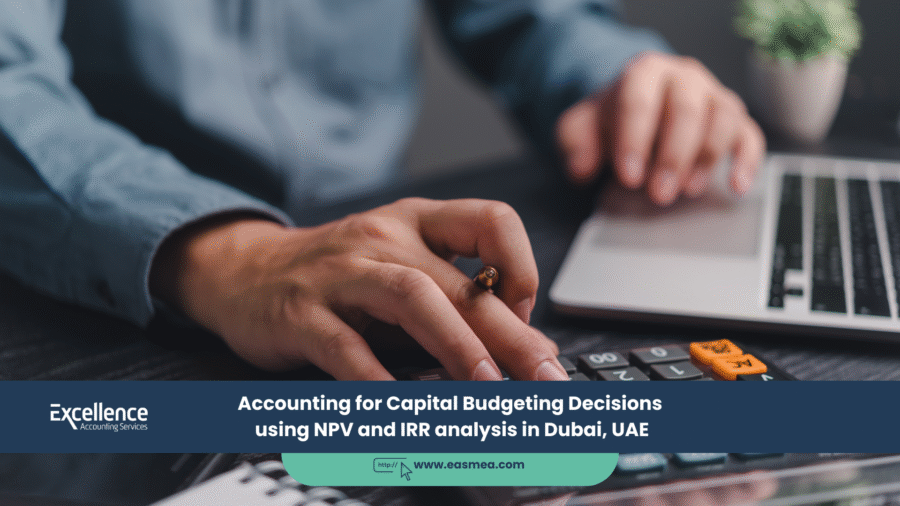Accounting for Capital Budgeting Decisions: NPV & IRR Analysis
Some of the most critical decisions a business will ever make involve capital budgeting—the process of analyzing and selecting long-term investments. These are not everyday operational choices; they are major strategic commitments of capital to projects like building a new factory, launching a new product line, or upgrading essential technology. A sound capital budgeting decision can secure a company’s future profitability, while a poor one can drain resources and hinder growth for years.
How do successful companies make these high-stakes decisions? They don’t rely on gut feeling. Instead, they use rigorous financial analysis techniques grounded in solid accounting data. The two most powerful and widely accepted methods for evaluating long-term projects are Net Present Value (NPV) and Internal Rate of Return (IRR). These tools allow businesses to look beyond simple profit and loss to understand the true economic value a project will create over its entire life.
This guide will demystify the accounting behind capital budgeting. We will explain how NPV and IRR work, the critical role the accounting department plays in providing the necessary data, and how to use these analyses to make investment decisions that drive sustainable value.
Key Takeaways
- Capital Budgeting is for Long-Term Investments: It’s the process for deciding on major projects with a lifespan of more than one year.
- It’s All About Cash Flow: NPV and IRR analyses are based on a project’s future cash flows, not its accounting profits.
- NPV Measures Value Creation: A positive NPV means the project is expected to generate more value than it costs, increasing the wealth of the owners.
- IRR Measures Rate of Return: The IRR is the project’s expected percentage return. If the IRR is higher than the company’s cost of capital, the project is financially attractive.
- Accounting Data is the Foundation: The accuracy of any capital budgeting analysis depends entirely on the quality of the accounting data used for the initial investment cost and cash flow projections.
The Core Methods: NPV and IRR Explained
To make an informed decision, you need to compare the cash you invest today with the cash you expect to receive in the future. Because a dirham today is worth more than a dirham tomorrow (due to inflation and opportunity cost), we must “discount” future cash flows to see what they are worth in today’s terms.
Net Present Value (NPV)
NPV is considered the gold standard in capital budgeting. It calculates the difference between the present value of a project’s future cash inflows and the present value of its cash outflows (primarily the initial investment). The formula is conceptually simple:
NPV = [Present Value of all future cash inflows] – [Initial Investment Cost]
To calculate the present value, future cash flows are discounted using the company’s “cost of capital” (the required rate of return). The decision rule is straightforward:
- If NPV is positive, the project is expected to generate a return greater than the required rate of return. Accept the project.
- If NPV is negative, the project’s return is less than required. Reject the project.
A detailed feasibility study is essentially a comprehensive exercise in calculating a project’s NPV.
Internal Rate of Return (IRR)
The IRR is another popular method that looks at the decision from a different angle. Instead of calculating a value in dirhams, it calculates a percentage rate of return. The IRR is defined as the discount rate at which the NPV of a project equals zero. In other words, it’s the project’s breakeven rate of return.
The decision rule is to compare the IRR to the company’s cost of capital (also known as the “hurdle rate”):
- If IRR > Cost of Capital, the project is expected to earn more than it costs to fund. Accept the project.
- If IRR < Cost of Capital, the project is not profitable enough. Reject the project.
For more on these concepts, resources like Investopedia offer detailed explanations.
The Accountant’s Role: Fueling the Analysis
The NPV and IRR formulas are just mathematical models. Their output is only as reliable as the input data, and that data comes directly from the accounting and finance function. The key contributions are:
| Data Point | The Accountant’s Contribution |
|---|---|
| Initial Investment Cost | Accurately determining the full cost of the project, including the purchase price of assets, shipping, installation, and any initial working capital required. |
| Projected Operating Cash Flows | Working with sales and operations teams to forecast future revenues and expenses to arrive at a projection of annual cash flow for the life of the project. This requires robust financial reporting and analysis skills. |
| Determining the Discount Rate | Calculating the company’s Weighted Average Cost of Capital (WACC), which is used as the discount rate for NPV calculations and the hurdle rate for IRR. This is a key task for our CFO services. |
| Tax Implications | Factoring in the impact of depreciation on taxable income and calculating how UAE Corporate Tax will affect the project’s net cash flows. |
Capital budgeting is where accounting moves from recording the past to shaping the future. The quality of the financial analysis determines the quality of the company’s future investments.
What Excellence Accounting Services (EAS) Can Offer
Making sound capital budgeting decisions requires rigorous financial modeling and strategic analysis. Excellence Accounting Services provides the expertise to support this critical process.
- Feasibility Studies & Financial Modeling: We build comprehensive financial models to analyze potential investments, calculating the NPV, IRR, payback period, and other key metrics to give you a clear picture of a project’s viability.
- Capital Budgeting Advisory: Our business consultancy services help you establish a formal capital budgeting process, set appropriate hurdle rates, and rank competing investment opportunities.
- Business Valuation: The same discounted cash flow (DCF) techniques used in NPV are central to business valuation. We can help you understand how a major project will impact the overall value of your enterprise.
- Due Diligence Support: If your investment involves acquiring another business or asset, we provide the financial due diligence needed to verify the financial assumptions underlying your analysis.
Frequently Asked Questions (FAQs)
The payback period is the length of time it takes for a project to recoup its initial investment. While simple to calculate, it’s considered inferior because it ignores the time value of money and completely disregards any cash flows that occur after the payback period has been reached.
For mutually exclusive projects (where you can only choose one), NPV is generally considered the superior method. NPV measures the absolute increase in value to the firm, while IRR can sometimes be misleading when comparing projects of different scales or cash flow patterns.
The cost of capital is the average rate of return a company must pay to its long-term investors (both equity and debt holders) for the use of their funds. It’s the minimum return a project must generate to be considered worthwhile. It is often referred to as the Weighted Average Cost of Capital (WACC).
This requires a combination of market research, analysis of comparable projects or products, and creating a detailed, assumption-driven financial model. You would forecast sales volumes, pricing, variable costs, and fixed costs based on the best available information.
Yes, but indirectly. Depreciation itself is a non-cash expense, so it is not included in the cash flow calculation. However, depreciation is a tax-deductible expense. It creates a “depreciation tax shield” (Depreciation x Tax Rate) which reduces the amount of tax paid, thereby increasing the project’s net cash flow.
Sensitivity analysis involves changing one key variable at a time (e.g., sales volume, cost of raw materials) to see how it impacts the project’s NPV or IRR. This helps you understand which assumptions are most critical to the project’s success and where the biggest risks lie.
Accounting profit (Net Income) includes non-cash expenses like depreciation and is based on accrual principles. Operating Cash Flow (OCF) starts with net income but adds back non-cash expenses and adjusts for changes in working capital. OCF is the true measure of cash generated by the project’s operations.
You must be careful. Unconventional cash flow patterns can result in multiple IRRs for the same project, making the metric unreliable. In these cases, NPV is a much more dependable decision-making tool.
You must be consistent. You can either use “nominal” cash flows (which include inflation) and discount them by a “nominal” cost of capital, or use “real” cash flows (with inflation stripped out) and discount them by a “real” cost of capital. Mixing them up will produce incorrect results.
The full initial investment, or Net Initial Outlay, includes the asset’s purchase price plus any shipping and installation costs. It must also include any additional investment in Net Working Capital (e.g., the extra inventory or accounts receivable needed to support the new project).
Conclusion: Investing in a Profitable Future
Capital budgeting is the process through which a company allocates its precious resources to shape its future. By moving beyond simple payback calculations and embracing the more sophisticated, cash-flow-based methods of NPV and IRR, decision-makers can gain a much clearer understanding of the true economic value of their investment choices.
Grounded in solid accounting data and rigorous analysis, these techniques provide a powerful framework for allocating capital efficiently, managing risk, and building a more profitable and sustainable enterprise.
Make Every Investment Count.
Let Excellence Accounting Services build the financial models and provide the strategic insights you need to confidently evaluate and select your next major project.




